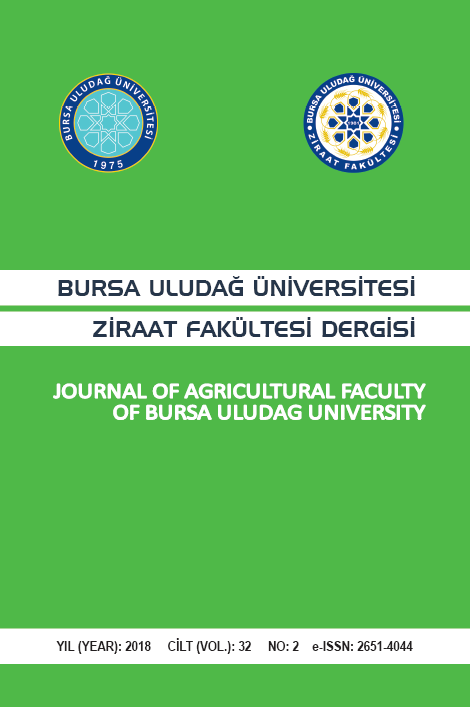Eyüp Selim KÖKSAL, Sakine ÇETİN, Ali Osman DEMİR, Emre TUNCA, Burak Nazmi CANDOĞAN, Ş.Tülin AKKAYA ASLAN
Bursa Karacabey Ovasında Son 25 Yılda Değişen Bitkisel Üretim Deseni ve Sulama Uygulamalarının Uzaktan Algılama ve ET Haritalama Tekniği ile Değerlendirilmesi
Tarımsal üretimde bitki deseni, sulama ve gübreleme gibi konularda alınan kararlar, sosyo-ekonomik koşullar, tarımsal alt yapı olanakları ve teknolojik değişimler doğrultusunda bir yıldan diğerine farklılık gösterebilmektedir. Karacabey Ovası hem Marmara Bölgesi hem de Türkiye için önemli düzeyde tarımsal üretim potansiyeline sahip ovalardan birisidir. Yakın geçmişte ovanın üretim potansiyelinin arttırılmasına yönelik sulama ve arazi toplulaştırması gibi önemli tarımsal alt yapı yatırımları gerçekleştirilmiştir. Tarım alanlarının izleme ve değerlendirilmesinde, uzaktan algılama teknikleri, örneklemeye dayalı tekniklere göre, daha etkili, ucuz ve pratiktir. Bu çalışmada, 1990-2015 yılları arasında Karacabey Ovası’na ait, Landsat 5 TM ve Landsat 8 uydu görüntüleri işlenerek, vejetasyon ve evapotranspirasyon (ET) durumunu temsil eden haritalar hazırlanmıştır. Aynı dönemlere ait görüntüler kendi içerisinde değerlendirilerek, Karacabey Ovası’nda söz konusu zaman diliminde sulama suyu kullanım durumu ve bitkisel üretim desenindeki genel değişimler değerlendirilmiştir.
Anahtar Kelimeler:
Uzaktan algılama, evapotranspirasyon, landsat uydu görüntüleri, vejetasyon indeksleri
Evaluation of Cropping Pattern and Irrigation Regimes Variation within The Last 25 years Through Remote Sensing and ET Mapping Techniques
Cropping pattern of agricultural production could be changed from one year to another based on, decisions made about irrigation and fertilization, socio-economic situations, agricultural infrastructure opportunities and technological improvements. Karacabey Plains is one of the important areas of Turkey and Marmara region which have an important agricultural production potential. In order to increase the agricultural production in plains land consolidation and irrigation infrastructure have been re-established. Remote sensing offers more cheaper and practical tools instead of techniques depending on sampling, for agricultural management. In this study, vegetation and evapotranspiration (ET) maps of Karacabey Plains were generated by processing the Landsat 5 and 8 satellite images. By this way, these maps were evaluated to understand the change of cropping pattern and irrigation water usage in Karacabey Plains.
___
- Allen, R.G., L.S. Pereira, D. Raes and M. Smith. 1998. Crop Evapotranspiration, FAO Irrigation and Drainage Paper. No. 56.
- Allen, R.G., M. Tasumi, A. Morse and R. Trezza. 2005. A Landsat-based energy balance and evapotranspiration model in Western US water rights regulation and planning. Irrig. Drain. Syst. 19. 251-268.
- Allen, R.G., M. Tasumi and R. Trezza. 2007a. Satellite-based energy balance for mapping evapotranspiration with internalized calibration (METRIC)–Model. J. Irrig. Drain. Eng. 133(4). 380–394.
- Allen, R.G., J.L. Wright, W.O. Pruitt, L.S. Pereira and M.E. Jensen. 2007b. Water requirements. In: Hoffman, G.J., R.G. Evans, M.E. Jensen, D.L. Martin and R.L. Elliot, (Eds.). Design and Operation of Farm Irrigation Systems. Second Ed. ASABE. St. Joseph, MI, USA, pp. 208–288.
- Allen, R.G., I.A. Walter, R. Elliott, T. Howell, D. Itenfisu and M. Jensen. 2005. The ASCE Standardized Reference Evapotranspiration Equation. Environmental and Water Resources Institute of the American Society of Civil Engineers January, Final Report.
- Anderson, M.C., J.M. Norman, J.R. Mecikalski, J.A. Otkin and W. P. Kustas. 2007. A climatological study of evapotranspiration and moisture stress across the continental United States based on thermal remote sensing: 1. Model formulation. J. Geophys. Res. 112. D10117.
- Anonim 2015. www.dsi.gov.tr
- Anonymous 2015. https://landsat.usgs.gov/
- ASCE–EWRI. 2005. The ASCE Standardized reference evapotranspiration equation. ASCE-EWRI Standardization of Reference Evapotranspiration Task Comm.
- Bastiaanssen, W.G.M. and M.G. Bos. 1999. Irrigation performance indicators based on remotely sensed data: a review of literature. Irrig. Drain. Syst. 13. 291-311.
- Bastiaanssen, W.G.M. and K.M.P.S. Bandara. 2001. Evaporative depletion assessments for irrigated watersheds in Sri Lanka. Irrig. Sci. 21. 1-15.
- Bastiaanssen, W.G.M., M. Menenti, R.A. Feddes, A.A.M. Holtslag. 1998a. A remote sensing surface energy balance algorithm for land (SEBAL). 1. Formulation. J. Hydrol. 212-213. 198-212.
- Bastiaanssen, W. G. M., H. Pelgrum, J. Wang, Y. Ma, J.F. Moreno, G.J. Roerink and T. van der Wal. 1998b. A remote sensing surface energy balance algorithm for land (SEBAL). 2. Validation. J. Hydrol. 212-213. 213-229.
- Droogers, P., W.W. Immerzeel and I.J. Lorite. 2010. Estimating actual irrigation application by remotely sensed evapotranspiration observations. Agric. Water Manage. 97. 1351-1359.
- Gowda, P.H., J.L. Chávez, P.D. Colaizzi, S.R. Evett, T.A. Howell and J.A. Tolk. 2008. ET Mapping for agricultural water management: present status and challenges. Irrig. Sci. 26(3). 223-237.
- Kjaersgaard, J.H., R.G. Allen, M. Garcia, W. Kramber and R. Trezza. 2009. Automated Selection of Anchor Pixels for Landsat based Evapotranspiration Estimation, World Environmental and Water Resources Congress: Great Rivers ASCE, 4400-4410.
- Norman, J. M., W.P. Kustas, J.H. Prueger and G. R. Diak. 2000. Surface flux estimation using radiometric temperature: Adual-temperature-difference method to minimize measurement errors. Water Resour. Res. 36(8). 2263-2274.
- Polhamusa, A., J.B. Fishera and K.P. Tu. 2013. What controls the error structure in evapotranspiration models? Agric. Forest Meteorol. 169. 12-24.
- Su, Z. 2002. The Surface Energy Balance System (SEBS) for estimation of turbulent heat fluxes SEBS-The Surface Energy Balance. Hydrol. Earth Syst. Sci. 6(1). 85-100.
- Tasumi, M., R.G. Allen and R. Trezza. 2008. At-Surface Reflectance and Albedo from Satellite for Operational Calculation of Land Surface Energy Balance. J. Hydrol. Eng. 13(2): 51-63.
- Wu, B., N. Yan, J. Xiong, W.G.M. Bastiaanssen, W. Zhu and A. Stein. 2012. Validation of ETWatch using field measurements at diverse landscapes: A case study in Hai Basin of China. J. Hydrol. 436-437. 67-80.
- Yayın Aralığı: Yılda 2 Sayı
- Başlangıç: 1982
- Yayıncı: Bursa Uludağ Üniversitesi
Sayıdaki Diğer Makaleler
Sulama Projelerinde Arazi Toplulaştırmasının Gerekliliği: Daphan Sulaması Örneği
Aynur FAYRAP, A.Vahap YAĞANOĞLU, Recep YANIK
Cevher İlhan CEVHERİ, Ahmet YILMAZ
Kemal Sulhi GÜNDOĞDU, Benjamin B. BANTCHİNA
Esra AYDOĞAN ÇİFTÇİ, Canser DOLGUN
Doğal Düşmanlarda İnsektisit Direnci
Samet ÇİÇEK, Barış KİLERCİOĞLU, Ramazan DOĞAN, Emine BUDAKLI ÇARPICI
Karma Yem Teknolojisindeki Gelişmelerin Karma Yem Kalitesine ve Yem Değerine Etkileri
Akuakültürde Akuaponik Sistemler ve Önemi
Sütün Enzimatik Koagülasyonu ve Peynir Üretiminde Bitkisel Pıhtılaştırıcılar
